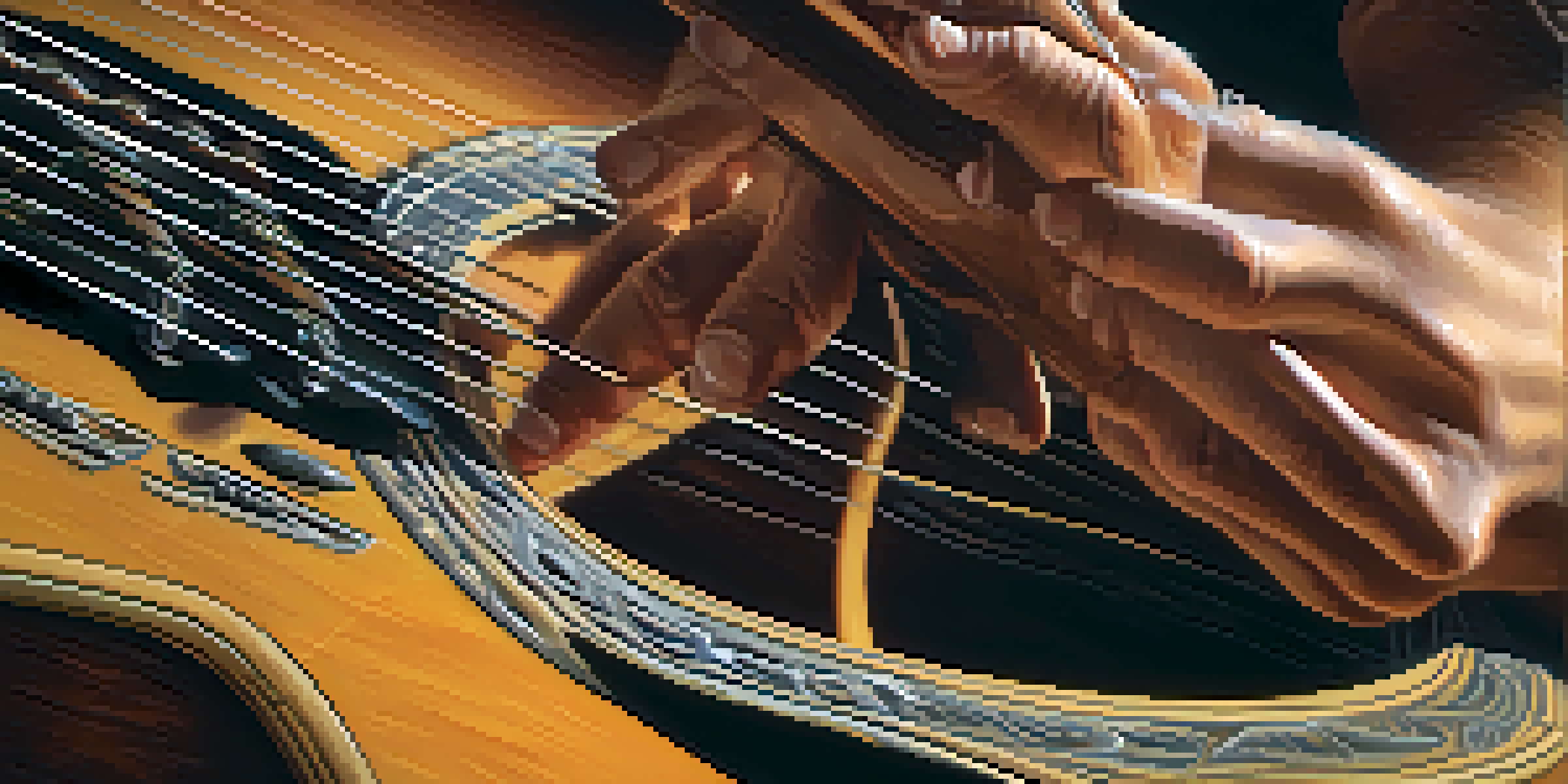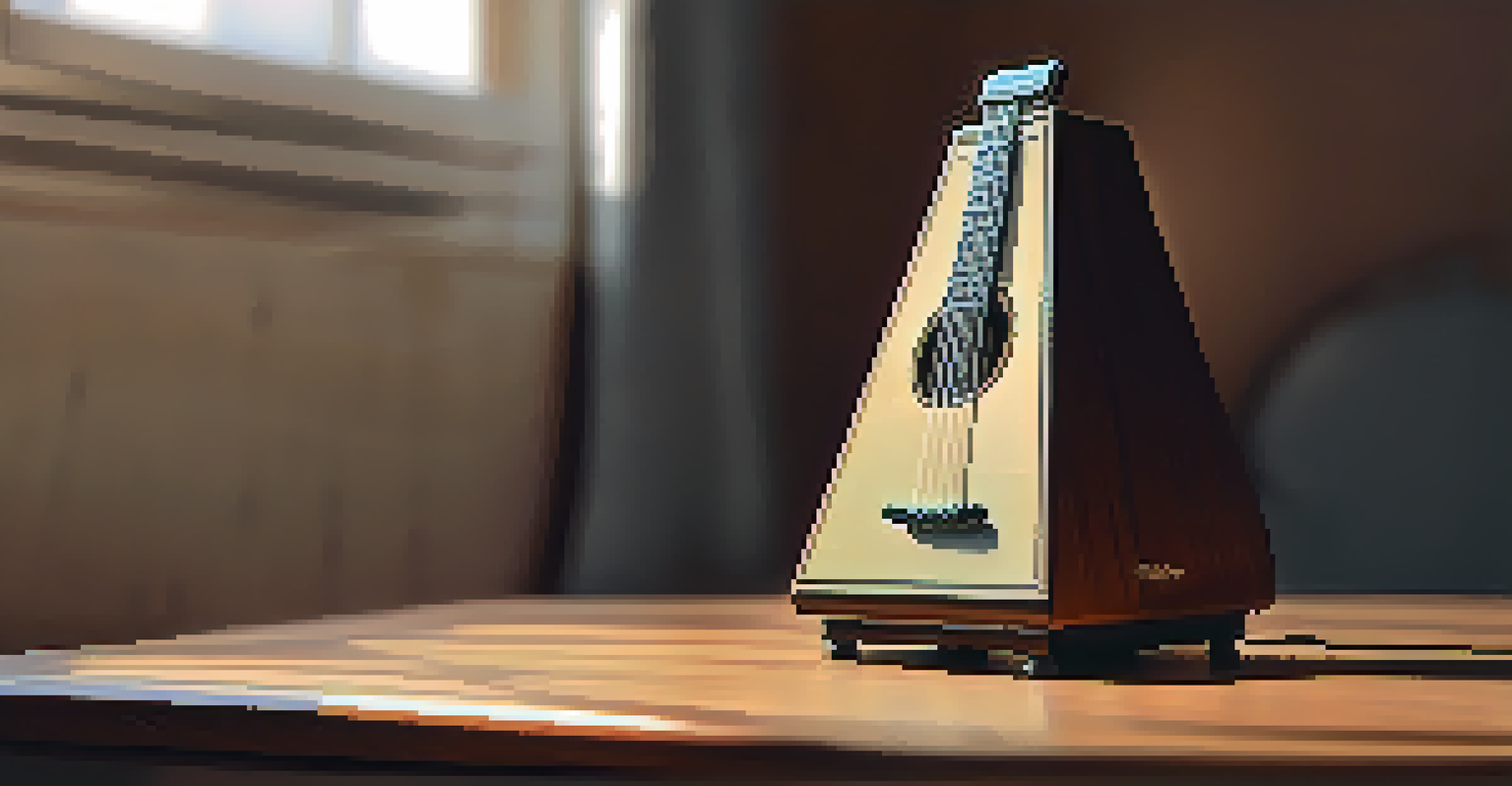Understanding Basic Strumming Techniques for Beginner Guitarists

What is Strumming and Why is it Important?
Strumming is a fundamental technique in guitar playing that involves sweeping your pick or fingers across the strings. It's crucial for creating rhythm and adding texture to your music. Without strumming, playing chords can feel flat and uninteresting, making it harder to engage your audience.
Strumming is the heartbeat of your music; it gives life to every chord you play.
Think of strumming as the heartbeat of a song; it gives life to the chords you play. Just as a drummer keeps time, your strumming patterns set the pace and feel for the music. Mastering this technique can transform your guitar playing from basic to captivating.
Whether you're playing folk, rock, or pop, strumming is essential. It allows you to express yourself and connect with the song on a deeper level. Understanding and perfecting your strumming technique can significantly elevate your overall musicianship.
Essential Tools You'll Need
Before diving into strumming, make sure you have the right tools. A good quality guitar and a pick are essential for beginners. While it’s possible to strum with your fingers, a pick can provide more control and a brighter sound, especially when you're just starting.

Another helpful tool is a metronome, which can help you keep a steady rhythm as you practice. This device ticks away at a consistent pace, ensuring you develop a sense of timing. Additionally, having a comfortable spot to practice can make all the difference in your learning experience.
Strumming Adds Rhythm to Music
Strumming is essential for creating rhythm and texture in your guitar playing, making songs more engaging.
Lastly, don’t forget about online resources! Many websites and apps offer tutorials on strumming patterns and exercises. With the right tools in hand, you’ll be well-equipped to start your strumming journey.
Basic Downstrokes: The Foundation of Strumming
The downstroke is the simplest strumming motion, making it perfect for beginners. To perform a downstroke, simply move your pick or fingers down across the strings in one smooth motion. This technique is often used in various genres and can be practiced with any chord.
Practice doesn’t make perfect. Perfect practice makes perfect.
Start by strumming down on each beat of a metronome. This will help you develop a steady rhythm. As you get comfortable, try to add some dynamics by varying the pressure of your strum, which can add depth to your sound.
Remember, consistency is key! Practice your downstrokes until they feel natural. Once you’ve mastered this basic technique, you’ll have a solid foundation to build upon as you explore more complex strumming patterns.
Introducing Upstrokes for a Balanced Sound
After getting comfortable with downstrokes, it’s time to introduce upstrokes. This technique involves strumming upwards across the strings and complements the downstrokes beautifully. Together, these two motions create a balanced, flowing sound that adds rhythm to your playing.
To practice upstrokes, start with the same chords you used for downstrokes. Strum upwards immediately after your downstroke. A common practice exercise is to alternate between downstrokes and upstrokes in a steady rhythm to build your coordination.
Practice Balance with Down and Upstrokes
Mastering both downstrokes and upstrokes is crucial for developing a balanced and expressive strumming technique.
Incorporating upstrokes into your playing can make a huge difference. It allows for more expressive playing and can help you develop a unique strumming style over time.
Understanding Strumming Patterns: The Next Step
Once you’re comfortable with downstrokes and upstrokes, it's time to explore strumming patterns. These are sequences of downstrokes and upstrokes that create a unique rhythm for each song. Patterns can vary widely, so experimenting with different ones can keep your practice sessions fresh and exciting.
A popular beginner pattern is the D-DU-UDU, which translates to down, down-up, up-down-up. Practicing this pattern with simple chords can help you develop timing and coordination. Remember, it’s all about finding a rhythm that feels comfortable for you.
As you practice, listen to your favorite songs and try to identify their strumming patterns. This will not only improve your ear but also inspire you to create your own unique patterns in the future.
Tips for Practicing Strumming Techniques Effectively
Practice makes perfect, but how you practice matters. Start slow, focusing on accuracy and consistency before increasing your speed. Using a metronome can help you maintain a steady tempo while you work on your strumming patterns.
Recording yourself can also provide valuable feedback. Listening to your recordings will help you identify areas for improvement and track your progress over time. Plus, it can be incredibly motivating to hear how much you've improved!
Avoid Common Beginner Mistakes
New guitarists should focus on maintaining a relaxed grip and practicing with a metronome to improve consistency and timing.
Lastly, don’t forget to have fun! Playing guitar should be an enjoyable experience. Explore different songs and styles, and let your creativity shine as you experiment with your strumming techniques.
Common Mistakes to Avoid as a Beginner
As a beginner, it’s easy to fall into a few common pitfalls. One of the biggest mistakes is strumming too hard, which can lead to a harsh sound and make it difficult to play consistently. Instead, focus on developing a relaxed grip and a smooth motion to produce a cleaner sound.
Another common mistake is neglecting to practice with a metronome. Many beginners tend to rush through their strumming patterns, which can lead to uneven timing. Make it a habit to practice with a metronome to build a solid sense of rhythm.

Lastly, don’t be discouraged by slow progress. Everyone learns at their own pace, and it's perfectly normal to face challenges along the way. Celebrate your small victories and keep pushing forward; improvement will come with time and practice!